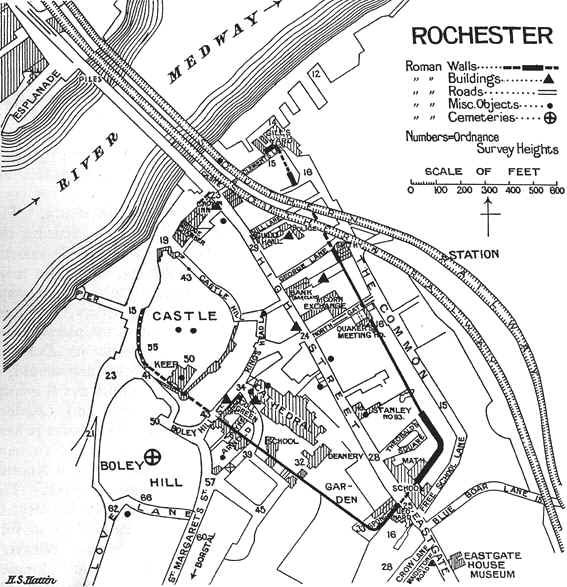Victoria
County History of Kent Vol. 3
1932 - Romano-British
Kent - Towns - Page 82
|
Kentish rag and flints often laid roughly
aslant, set in a hard brown, pebbly mortar containing
occasional fragments of brick; the facing is of squared blocks
of Kentish rag, each about 7 in. deep, with mortar joints
averaging between 2 in. and 3 in. Occasional lacing-courses of
brick are somewhat vaguely recorded. Fisher, in his History
of Rochester (p.3), states that particularly in the
portion towards ‘the west end of the north wall’ Roman
bricks were conspicuous. The wall in Gill’s Yard (adjoining
the river at the north corner of the town) had a ‘double
bonding-course of tiles,’ but at what height is. not stated.
Again, in ‘Miss Spong’s garden,’ close to the southern
corner, |
|

Fig. 14.—Plan of Roman Rochester
Based on the Ordnance
Survey Map, with the sanction of the Controller of H.M.
Stationery 0ffice
|
|
Payne claimed to have found, on the summit
of the wall at a height of 12 ft. or more above the base, the
remains of a bonding-course of Roman tiles. If, however, these
bonding-courses are not evidence merely of local repairs, they
must, at least, have occurred at very infrequent vertical
intervals; certainly no trace of them can now be seen,
although the wall at ‘Miss Spong’s garden’ still stands
much as it stood in Payne’s day. It may be added that there
is no record of the occurrence of re-used materials in the
structure of the |
Previous
Page Page 82
Next Page
Back
to Towns page listings
Contents
Page
This website is constructed
by enthusiastic amateurs. Any errors noticed by other researchers will be gratefully received so
that we can amend our pages to give as accurate a record as
possible. Please send details to localhistory@tedconnell.org.uk
|